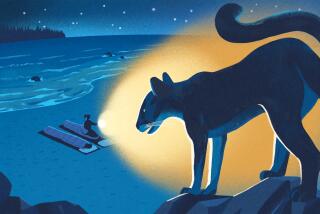The Lion and the Jogger
COOL — Piecing it all together later, the trackers concluded that the mountain lion must have watched Barbara Schoener from above, behind a cover of rock and brush. Maybe she had startled the lion from a morning nap. Maybe it was sick with rabies, or simply hungry. For whatever reason, it did something mountain lions rarely do. It dropped down to the trail and fell in behind the jogger.
Schoener, a fit 40-year-old, weighed 120 pounds. The lion weighed more. It closed, fast and quiet, from a distance of 20 feet. The first blow knocked Schoener down a steep slope. Footprints indicate she took two long strides before she fell. The lion pounced. Somehow, Schoener picked herself up and scrambled downhill another 25 feet. The lion pounced again.
“Defensive wounds on Barbara’s forearms and hands,” El Dorado County sheriff’s investigators reported later, “make it apparent she did struggle with the lion.” Any one of two wounds, one to the neck, the other to the skull, could have been lethal. The lion dragged what it didn’t eat 100 yards away, covering the remains with leaves.
This was early last Sunday morning. Sometime later that night--again, from a reading of the tracks--the lion returned to its cache. By then, however, the body had been discovered and taken away by helicopter. By then, the lion was the one being hunted.
*
This little town is located near Auburn, about an hour from Sacramento. It is named after the Rev. Aaron Cool, who traveled the hills on horseback during the Gold Rush, preaching to miners in saloons. To judge by the proliferation of real estate storefronts and billboards here, the population boom rumbling through the Sierra foothills--as restless Californians take flight from city and suburb alike--has not bypassed Cool.
More than 2,000 people reside here, most of them migrants from Los Angeles and San Francisco who live within a 900-home gated community called Auburn Lake Trails. The attractions are obvious. The development is well-kept, the lots large, the prices modest by city standards. Deer roam the streets. The woods are a short walk in any direction.
The attack on Schoener--believed to be the first killing of a Californian by a mountain lion in this century--occurred among a network of winding trails that borders the community. Schoener, a marathon runner and mother of two, lived 30 miles away, but she came often to train on the trails. For the Auburn Lake residents, her death has been cause for healthy reflection. “Somebody got killed and eaten,” said Fred Jones, a free-lance nature writer who lives close to the attack site. “This is serious business.”
This is not to suggest, however, a general panic. Schoolchildren have been advised to avoid the trails and stick together. Pets have been taken in nights. Everyone’s a bit more cautious, but no one is packing for L.A. As the manager of the property owners association put it: “They’d rather take precautions against a possible mountain lion attack, than take precautions against a possible drive-by shooting.”
*
This attitude might serve the residents well, but it doesn’t resolve some of the stickier questions raised by the attack. Since the killing, teams of hunters and dogs have picked slowly through the hills. The operation, run by the state Department of Fish and Game, is intended to track down the mountain lion and kill it. So far the hunt has come up empty. In the meantime, though, the public’s calls to Fish and Game have been running about 60-40 against killing the cat.
“One gentleman,” a state biologist recalled, “volunteered to lead the mountain lion out of the area. People think of these animals as soft, cuddly things; they are efficient killers.” A sheriff’s investigator said he’s received demands that the cat be trapped and relocated. “The answer to that one,” he said, “is to say: Fine, can I put it in your back yard?”
Differing explanations for the attack rattle through the community. Some see it as a total aberration, the work of a rogue animal. Others blame a statewide proposition that banned mountain lion hunts, causing the unmanaged population to more than double. Still others point to newcomers who treat deer almost like pets; as deer move closer seeking handouts, mountain lions follow, seeking deer.
Finally, there are those who subscribe to the laws of probability. The real estate boom made such a tragedy inevitable. With more people in the hills, and more mountain lions, more encounters were bound to happen. This theory seems to have logic on its side. It also is the most fatalistic. For lions always will behave as lions, and developers as developers. And there seems to be no outrunning either species.
More to Read
Sign up for Essential California
The most important California stories and recommendations in your inbox every morning.
You may occasionally receive promotional content from the Los Angeles Times.











